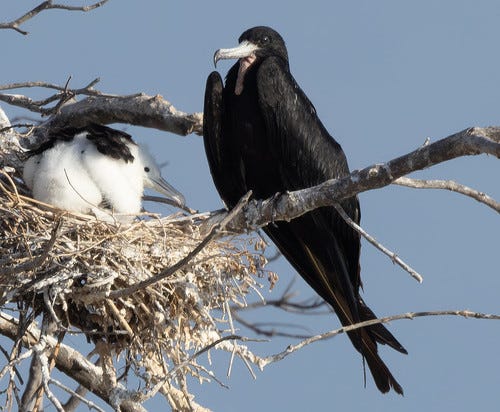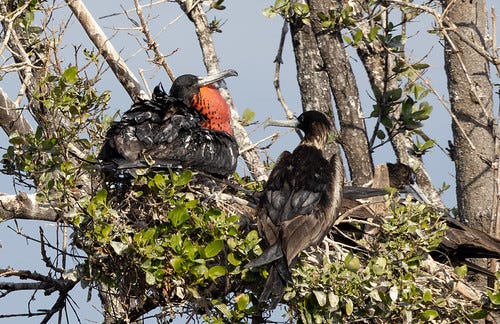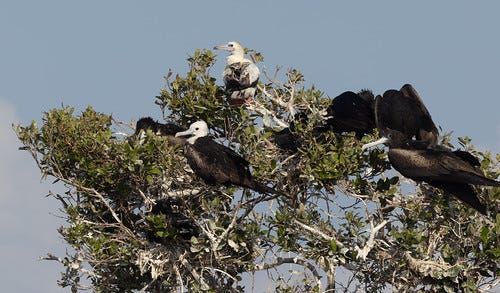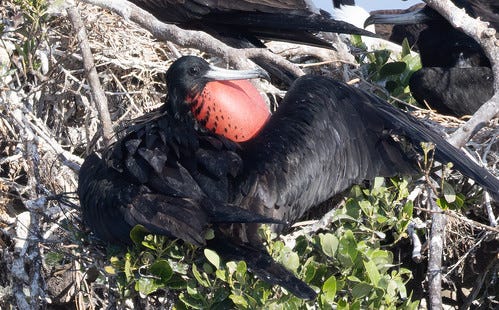(Listen to the radio version here.)
The Magnificent Frigatebird is a species of almost mind-boggling contradictions. This true seabird, feeding exclusively on ocean creatures and spending its entire life at sea, cannot swim! The vestigial webs between its toes make its feet “semipalmated,” more similar to the feet of a shorebird than a duck, and its legs are too short and its feet much too tiny to paddle or to run on the water’s surface to take off. (It can’t even walk on land.)
And the frigatebird’s feathers are not at all waterproof—indeed, they’re so wettable that if a frigatebird did end up in the water, it couldn’t get out again even with more aquatically designed feet.
So how does a frigatebird get every single calorie it needs out of that big, deep ocean? It gets most of its food by grabbing squid and flying fish at or barely below the water’s surface; it also sometimes picks up discards from fishing boats. But when the pickin’s are slim, it also steals prey from other seabirds—a behavior called kleptoparasitism. I once watched one pluck a tiny fish right out of a tern’s bill.
Unlike terns, most fish-eating birds such as boobies, gannets, and tropicbirds swallow their prey before flying off. Frigatebirds, the true “pirates of the Caribbean,” earned their nickname, “man-o-war birds,” by vigorously harassing these large seabirds. When a hapless victim regurgitates its stomach contents, the frigatebird catches and swallows the vomit midair or off the water’s surface.
From our boat en route to the National Park, we watched one adult female frigatebird harass an immature Masked Booby for many minutes.
The frigatebird kept dive-bombing it and darting at it from every which way, and the poor booby kept trying to elude it. The booby dropped into the water several times, and when the frigatebird tried to peck it near the water’s surface, the booby dove deeper for a bit. But when the frigatebird backed off, rather than leaving well enough alone, the booby kept taking off again, and the frigatebird kept coming back and harassing it. Our boat went slowly through this area close to East Key where the Masked Boobies were nesting, and the young booby seemed to be trying to get closer to the island, so I couldn’t figure out why it didn’t simply swim there. Birds keep their reasons to themselves.
Unless the frigatebird had actually witnessed the booby catch and swallow a fish, it had no way of knowing for sure that the booby had any stomach contents to vomit, so it’s hard to say which bird was being more foolhardy. We saw plenty of flying fish on the boat ride, so it’s not like the frigatebird didn’t have alternatives.
A male frigatebird weighs slightly less than 2 ½ pounds yet has a 7-foot wingspan. In comparison, a Bald Eagle weighs at least 8 pounds (most weigh significantly more) yet has a slightly smaller wingspan. The eagle’s wings are broader, so the wing-loading isn’t quite so disparate, but except when an eagle is rising on a thermal air current or soaring toward the next one, it must flap its wings much more than a frigatebird to stay aloft. If you keep your binoculars trained on a single frigatebird soaring over the open sea as long as you can keep it in view, you probably won’t see it flap unless it’s harassing another seabird, but you might notice very subtle movements of the long, narrow wings as it makes delicate adjustments to even the slightest momentary fluctuations in the breeze.
Frigatebirds are exceptional among seabirds for having sexual dimorphism. Except for their throat pouch, adult males are pure black with a metallic purple sheen on their back and scapulars and a slightly greenish gloss on their crown, nape and wings; adult females are brown with a gleaming white breast and white sides of the neck and upper belly. The male’s forked tail is significantly longer than the female’s, but his body is smaller and he weighs significantly less.
The female selects her mate from the horde of males showing off their big red balloons, clattering their bills, waving their heads back and forth, and quivering their wings. Their pair-bond is not very long lasting—males stick around until their one and only chick is about 2 1/2 months old, and then fly off for good.
Scientists have conducted remarkably few detailed studies on frigatebird nesting behavior considering how conspicuous the breeding colonies are. Based on what we do know, the chick remains in the nest until it’s 5 or 6 months old, and continues being fed by its mother until its first birthday or even longer—some mothers are still feeding one-and-a-half-year-old chicks, so females nest only every second year, while males start the whole display/courtship routine and nest with a new female every year.
The clean glossiness of the male’s back feathers is probably a legitimate signal of his fitness as a potential mate and father, and males who successfully acquire and defend territories at the tops of the colony trees can show off those black feathers to perfection.
Males on lower layers of the trees get spattered with the droppings of the birds above. Some of the spatters are just tiny flecks of white, but some are much more noticeable.
As a boomer, I remember the larger-than-life character, Fonzie, from TV’s Happy Days. No way would the Fonz walk around with white splotches of bird poop on his shiny black leather jacket, much less allow anyone to literally sh*t on him, but despite their swaggering macho image and man-o-war reputation, pooped-upon frigatebirds don’t seem the least bit embarrassed about it, and the females who choose these males get pooped upon, too. I guess a bit of poop is no big deal for a bird who eats throw up.
Every now and then, a Red-booted Booby turns up in the Dry Tortugas, often hanging out in the frigatebird nest colony, and my birding tour group got to see one when we took a dinghy closer to the frigatebirds nesting on Long Key.
Even though boobies are smaller than frigatebirds and the Red-footed Booby is the smallest of all six booby species, this one was perched atop the highest branch in the tallest nest tree. Our guide, Rafael Galvez, said that when one is around, it invariably takes the highest spot like this.
Red-footed Boobies don’t nest in the Dry Tortugas. In their own nesting colonies, they all seem to select nest sites in the sun, avoiding places where overhanging branches might put other birds above them. Boobies got their name from ancient seafarers for seeming gullible and foolish, but I’d submit that sitting above the poop-line makes them pretty darned smart.
Or are they? Those white splotches on a frigatebird’s plumage all come out in the wash, or at least when it rains. When that Red-footed Booby eventually sets out to do some fishing, how long will it take for one of those man-o-war birds to get its revenge?
That’s the cool thing about birds—no matter how much we think we know, they always keep us guessing.

















